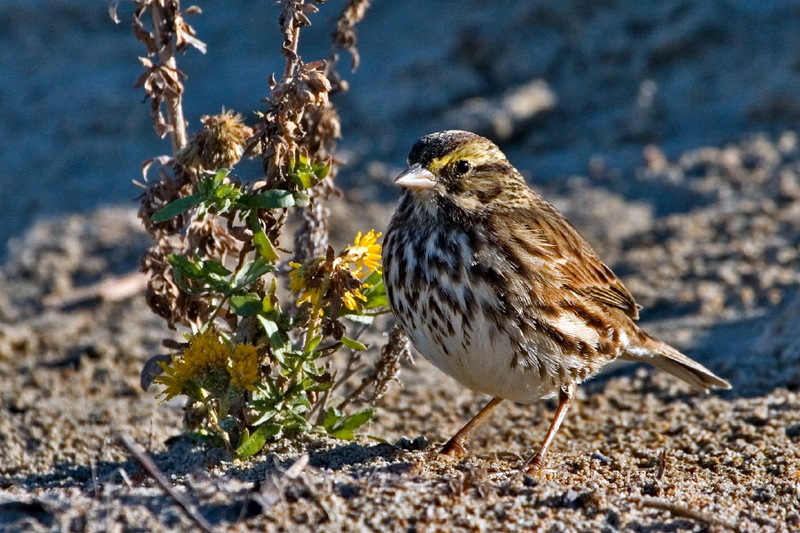Savannah Sparrow (Passerculus sandwichensis) - Wiki Savannah Sparrow
From Wikipedia, the free encyclopedia
[Photo] Passerculus sandwichensis - Savannah Sparrow, Bolsa Chica Ecological Reserve, Huntington Beach, California. Source NaturesPicsOnline www.naturespicsonline.com Date December 2006. Author Elaine R. Wilson
The Savannah Sparrow (Passerculus sandwichensis) is a small sparrow. It is the only member of the genus Passerculus (Bonaparte, 1838). Recent comparison of mtDNA NADH dehydrogenase subunit 2 and 3 sequences (Zink et al., 2005) indicates that the Ipswich Sparrow, formerly usually considered a good species (as Passerculus princeps), is a well-marked subspecies of the Savannah Sparrow, whereas the 2 southwestern subspecies should be recognized as distinct species.
This passerine bird breeds in Alaska, Canada, northern, central and Pacific coastal USA, Mexico and Guatemala. The Pacific and Mexican breeders are resident, but other populations are migratory, wintering from the southern United States to northern South America. It is a very rare vagrant to western Europe.
Savannah Sparrow is a very variable species, with numerous races, several of which have been split as separate species at various times. The different forms vary principally in the darkness of the plumage, with Alaskan and interior races the palest, and southern Pacific coastal forms the darkest.
This species has a typically sparrow-like dark-streaked brown back, and whitish underparts with brown or blackish breast and flank streaking. It has yellowish or whitish crown and eyebrow stripes. The cheeks are brown and the throat white.
The breeding habitat is a wide variety of open habitats including grasslands and cultivation. Savannah Sparrows nest on the ground, laying 3-6 eggs in a cup nest sheltered by a clump of grass or other vegetation. They form flocks in the winter to migrate.
These birds forage on the ground or in low bushes. They mainly eat seeds, but insects are also eaten in the breeding season. The song is mixture of chips and trills. The flight call is a thin seep.
This bird was named after Savannah, Georgia where one of the first specimens of this bird was collected.
Although this bird is generally abundant across its range, some coastal populations depending on salt marsh habitat are declining.
Fifteen subspecies plus the two Large-billed Sparrows are currently recognized. Four additional subspecies are not generally accepted. The subspecies are usually divided into several groups:
The Savannah Sparrows proper (migratory):
P. s. labradorius, breeds in Newfoundland, Labrador, and N Quebec
P. s. oblitus, breeds in N Ontario and Manitoba
P. s. savanna (Eastern Savannah Sparrow), breeds in the NE USA and adjacent Canada (includes P. s. mediogriseus)
P. s. sandwichensis (Aleutian Savannah Sparrow), breeds on the Aleutian Islands and W Alaskan Peninsula
P. s. anthinus, breeds in the remainder of Alaska, south and east to central British Columbia and north of the Great Plains to Manitoba
P. s. brooksi (Dwarf Savannah Sparrow), breeds in southernmost British Columbia to northernmost California
P. s. alaudinus, breeds in coastal northern and central California
P. s. nevadensis, breeds in the N Great Plains and the Great Basin
P. s. brunnescens, breeds from central Mexico south to Guatemala (includes P. s. rufofuscus)
P. s. wetmorei is a doubtful subspecies which may breed in the mountains of Guatemala. It is known from only 5 specimens, collected June 11-17, 1897, in Huehuetenango Department.
The Ipswich Sparrow (formerly considered a distinct species - see Zink et al., 2005 -, some post-breeding dispersal)
P. s. princeps, breeds almost exclusively on Sable Island
The Belding's Savannah Sparrows (resident):
P. s. beldingi, resident on the Pacific Coast from Morro Bay, California, to El Rosario, Baja California (includes P. s. bryanti)
P. s. anulus, resident around Sebasti??n Vizca??no Bay, Baja California
P. s. guttatus, resident around San Ignacio Lagoon
P. s. magdalenae, resident around Magdalena Bay
The San Benito Savannah Sparrow (resident)
P. s. sanctorum, Islas San Benitos
The Savannah Sparrows proper are very similar and migrant birds can not usually be related to a breeding population with certainty. The resident or partially migratory subspecies are well distinguishable by size and, particularly between groups, coloration. The Ipswich Sparrow is somewhat larger and paler in colour than other eastern Savannah Sparrows. The breast streaks are narrower and pale brown. Some birds overwinter on the island; others migrate south along the Atlantic coast, usually departing later and returning sooner than mainland birds. Some birds interbreed with P. s. savanna in Nova Scotia. These birds frequently raise three broods in a year. This bird was first observed in winter on the dunes near the town of Ipswich, Massachusetts.
The Large-billed Sparrows, best considered a distinct species (Zink et al, 2005), are:
Passercula rostratus rostratus (or P. s. rostratus), which breed on the Gulf Coast of NE Baja California and NW Sonora (some post-breeding dispersal.
P. r. atratus (or P. s. atratus), resident on the coast of central Sonora to central Sinaloa (resident)
http://en.wikipedia.org/wiki/Savannah_Sparrow
| The text in this page is based on the copyrighted Wikipedia article shown in above URL. It is used under the GNU Free Documentation License. You may redistribute it, verbatim or modified, providing that you comply with the terms of the GFDL. |
